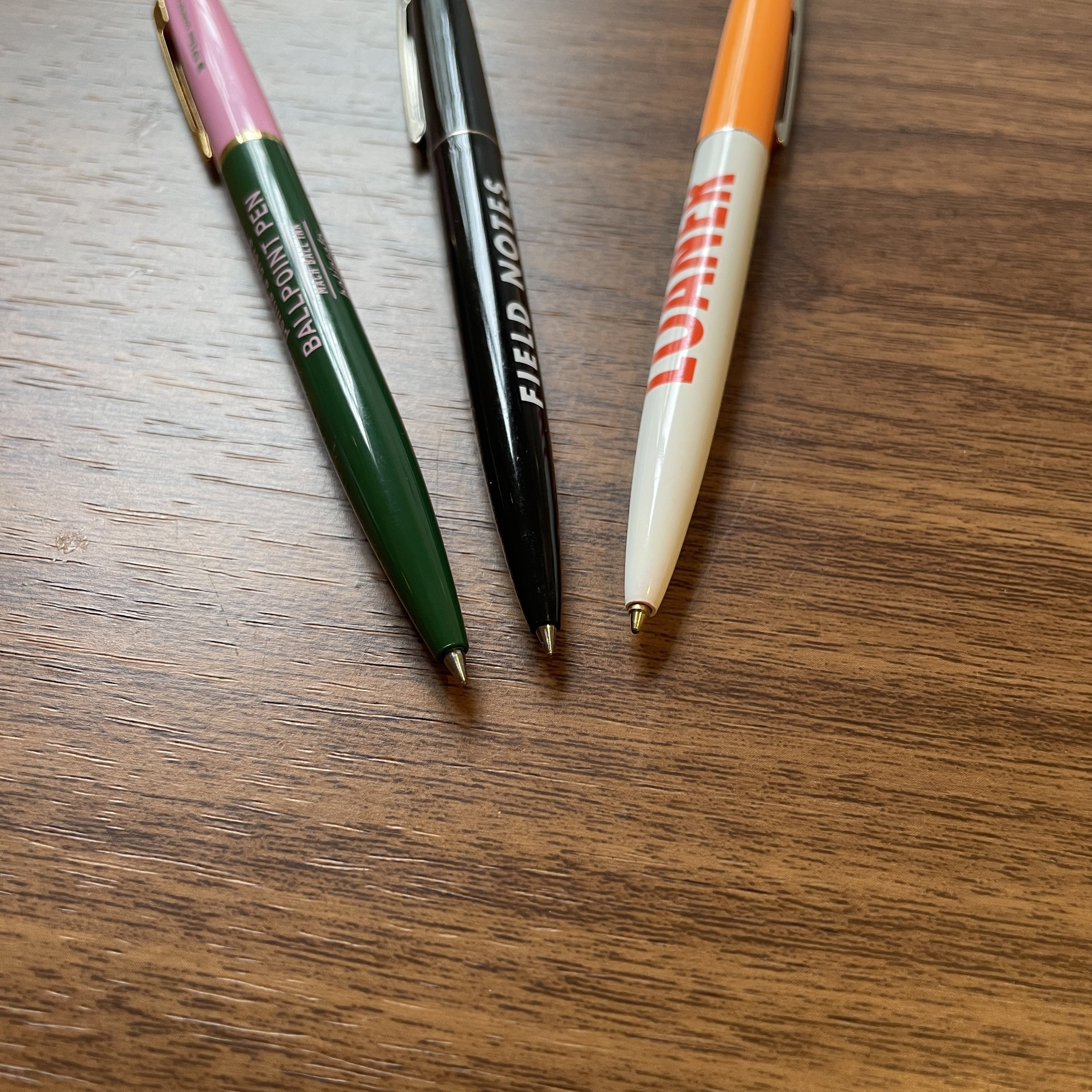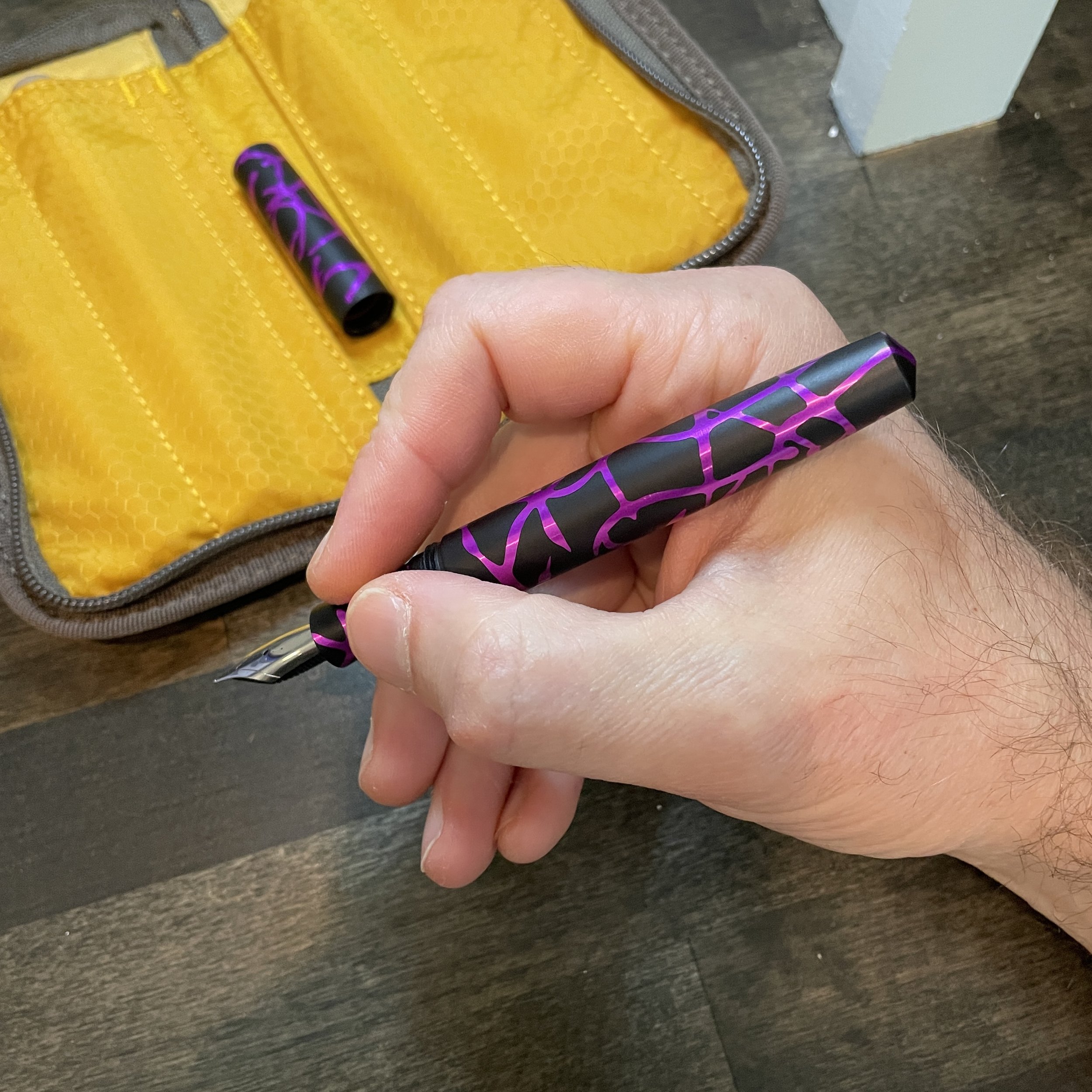Let’s face it: When it comes to actually getting work done, a fountain pen is never the most practical option. For me, it’s not so much the messiness, but more the added mental load and distraction. In addition to the work itself, you have to consider the nib, ink, paper, and how all three of these factors interact with one another. If any single thing goes wrong, it will break your focus, and while I’ve been in this long enough to have a pretty good instinct about what combinations do well enough to allow me to “just work”, lately half of my everyday writing has been with a ballpoint. But not just any ballpoint….
“Low-Viscosity” Ballpoints: An Excellent All-Around Workhorse Option
By now, you’ve likely heard the term “low-viscosity” ballpoint and wondered what the heck that means. I won’t get too deep into the science here, but it seems to be the new marketing term for what I’ve always referred to as “hybrid gel” ballpoint pens such as the Uniball Jetstream and the Pilot Acroball. Pen companies have modified their traditional oil-based ballpoint ink formulations to make them less “sticky,” which allows the pen to write darker, crisper lines, and results in quicker dry times with less smearing. As a result, today it’s actually fairly easy to find ballpoint pens in the .5mm (and even .38mm) tip sizes, which is difficult to pull off in a more traditional ballpoint ink formulations without clogging and skipping.
Lately I’ve been using a lot of needle-tip ballpoints. Low-viscosity ink allows you to have a very fine ballpoint line without running into problems with skipping. From left, the Mark’style Tous Les Jours ballpoint, the Traveler’s Company Brass Ballpoint, and my ever-reliable Lamy 2000 multipen with a Penco Needle-tip refill.
Five Excellent Low-Viscosity Ballpoint Pens
Unsurprisingly, Japanese companies dominate this product category. The Uniball Jetstream and Pilot Acroball tend to be the “gold standard” pens/refills, though there are boutique options available that, in my opinion, offer even crisper and finer ballpoint lines, including in needle-tip formats. Here are five to consider:
Uniball Jetstream and Pilot Acroball. Though they’re not necessarily exciting, these remain exceptionally good pens and excellent low-cost options. If I were stocking a workplace or office supply closet, this is where I would start. Uniball actually makes a Parker-style cartridge called the Jetstream SXR-600, which I have used to convert many of my rollerball pens like my Grey Caran d’Ache 849.
Traveler’s Company Ballpoint Pen and Needle-Tip Refill. A favorite for years, I own three of these pens. One is permanently clipped to my Plotter Mini-5, and the other two live in the breast pockets of my two winter coats, so they’re always available. I’ve found the needle-tips reliable, and despite the small size, the refills last for a very long time and are cheap to replace.
Mark’style “Tous Les Jours” Ballpoint with Ohto Needle-Tip Refill. If you don’t enjoy the format of the Traveler’s Company Ballpoint, and want something longer for better balance, these hexagonal wooden click pens from Mark’s Inc. contain an Ohto needle-tip ballpoint refill and feel like you’re writing with a woodcase pencil. The “Tous Les Jours” series from Mark’s is insanely popular, with what might be the finest needle tip on a ballpoint I have ever seen.
Penco “Perfection” Pocket Ballpoints and Pocket Drafting Ballpoint. I suspect that Penco uses a .7mm version of the Jetstream D1 refill (or something very similar) for it’s “Perfection” line of pocket ballpoints, and the pocket-sized “Drafting” Ballpoint uses a D1 needle-tip ballpoint refill that is an excellent option for other D1-compatible pens like the Lamy 2000 Multipen. I feel like both refills write a finer line than their respective .7mm and .5mm designation.
Mark’style x Anterique “Mach” Ballpoint. A new addition to the Curated Shop - one which I plan to continue to stock in additional formats - I discovered the “Mach” ballpoint refill by Japanese stationer Anterique during my trade show travels earlier this month. The .5mm, super-sharp ballpoint refill leaves a clean line, and as discussed below, is sold separately from the pen body and can be used to jazz up your collection of vintage Bic Clics.
Pen Hacks: Saving the Classic Mid-Century “Click” Pen
I don’t write about “refill hacks” very often, but when I discovered the Mark’s/Anterique pens earlier this month, and learned that the refill was sold separately, it got me wondering. I have a rather large personal collection of vintage and vintage-inspired “clic” ballpoints, which is ironic in the sense that while I love the format of this pen, I’ve grown to despise the standard refill. In my experience, these pens write much more inconsistently than the Bic Cristal, and I find the refills almost always skippy and too light. It begs the question: Can you use the Anterique “Mach” refill to upgrade your classic click pens? Maybe.
The fit isn’t perfect. The standard Bic Clic has thinner plastic around the opening. As a result, even with the upgraded refill you will have tip wiggle and rattling. Then again, it’s <$2. I still love it.
One odd thing I’ve noticed is that while the external design of the “Bic Clic”-style ballpoint hasn’t changed much over the years, these pens are far from identical on the inside. Some (frustratingly) use refills that are slightly longer and/or thicker than others, and there’s no real way to know which pens contain which parts other than to disassemble them. For pens designed to take the longer refills, there is an easy hack/fix that you can use to get the Anterique refill to fit. My notes below:
Field Notes Clic Pens and Pen Addict “Loaner” Pens are based on a version of the Bic Clic ballpoint that should take the Anterique refill without modification. (I say “should” because all that I can be certain of is that the Anterique refills fit the specific pens in my possession. It’s possible there isn’t refill or manufacturing consistency across product lines with these sorts of ballpoints, so YMMV.)
“Higher-end” Clic-style pens may need modification. I have a handful of “demonstrator” Bic Clics and some “fancy” Clic-style Kikkerland pens that required mild hacking to get them to work. Specifically, the Anterique refill was too short, but I was mostly able to fix the problem by wrapping a small piece of washi tape around the end of the refill to lengthen it. I was never able to get the Kikkerland pens to work 100% consistently, so if you don’t already own these I wouldn’t buy them for the purpose of modification.
You can adjust the length of the refill by wrapping a piece of tape around the end. Alternatively, if a refill is too long, you can trim the plastic a bit.
Of course, if you want to save yourself the trouble of refill hacking, or you don’t already have a large collection of vintage ballpoints, the Mark’s/Anterique pen bodies are a nice upgrade. The plastic is thicker, especially around the tip/opening, and as a result there is zero wiggle or annoying rattling when you write with them. (While Anterique pens are designed to mimic the vintage “disposable” pens in design, they’re actually intended to serve as nicer refillable pens. Stay tuned for a bunch of different colors and body styles that I have on the way, in addition to the Mark’s versions currently in stock.)
Writing Samples - various low-viscosity / needle-tip ballpoint inks on Write Notepads paper.
Further Reading
I’ve written a lot on ballpoint pens recently, and as I’ve explored the category it’s surprised me with both it’s relative depth and popularity among the surprising number of ballpoint pen enthusiasts. First of all, not everyone necessarily likes ultra-fine lines, and some people actually prefer the broader, slicker writing experience of a traditional ballpoint pen. If that’s you, there are some great options out there. In this post from November, I discuss two of my favorites: the Schmidt P900 (a “less goopy” version of the Schmidt Easyflow), and the Caran d’Ache Swissride, which fits the delightfully inexpensive Caran d’Ache Infinite 888 ballpoint pen. You can also get into “technical”-style ballpoints like the Rotring 600 or the TWSBI Precision, or explore the world of pressurized “write anywhere” refills like the Fisher Space Pen family. There’s an entire universe out there beyond fountain pens!
The Gentleman Stationer is supported entirely by purchases from the T.G.S. Curated Shop and pledges via the T.G.S. Patreon Program. This post does not contain paid affiliate links or third-party advertising.





